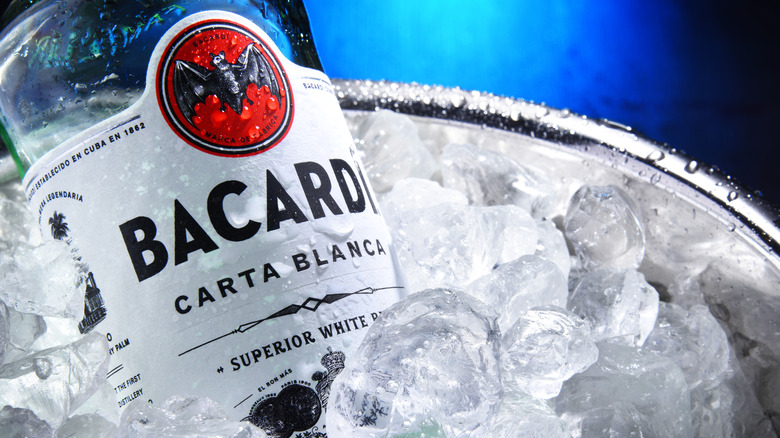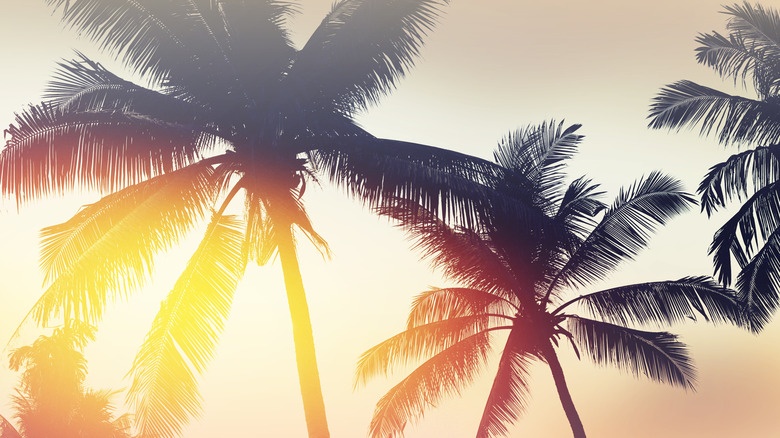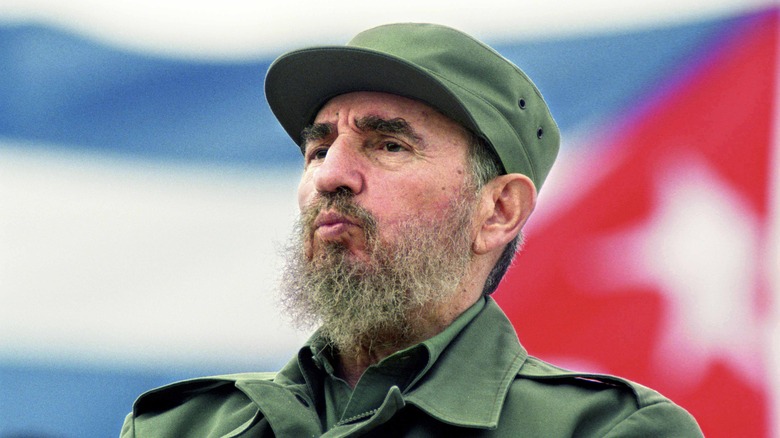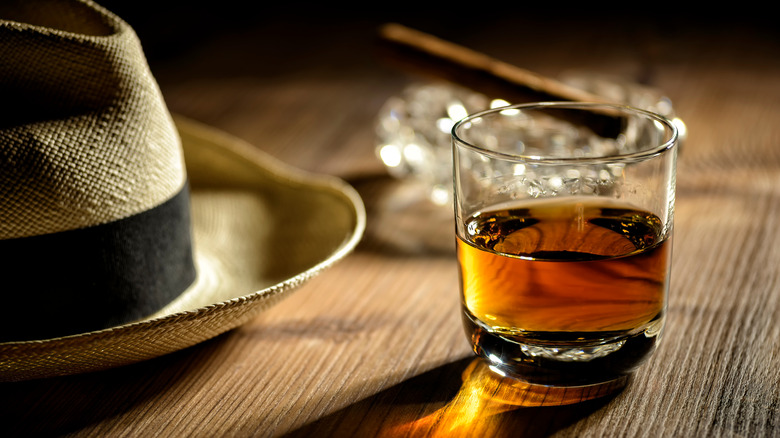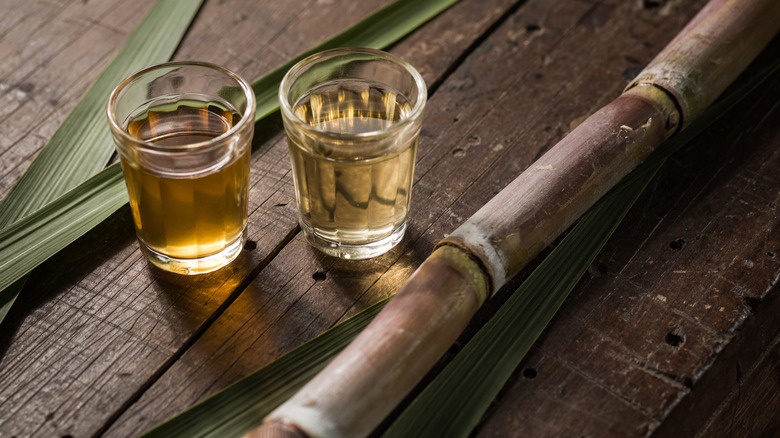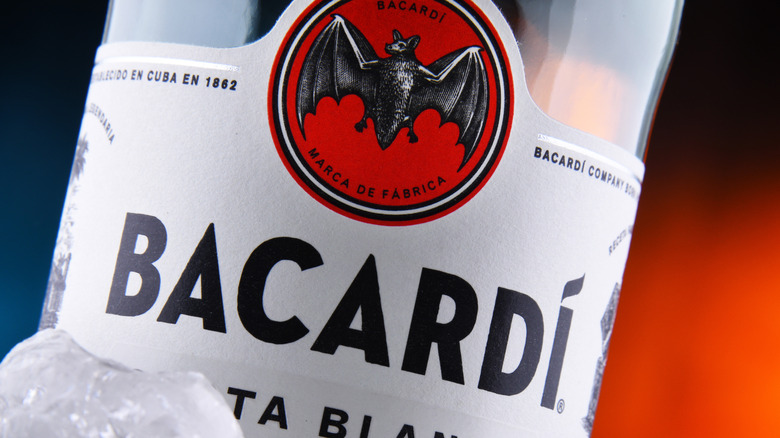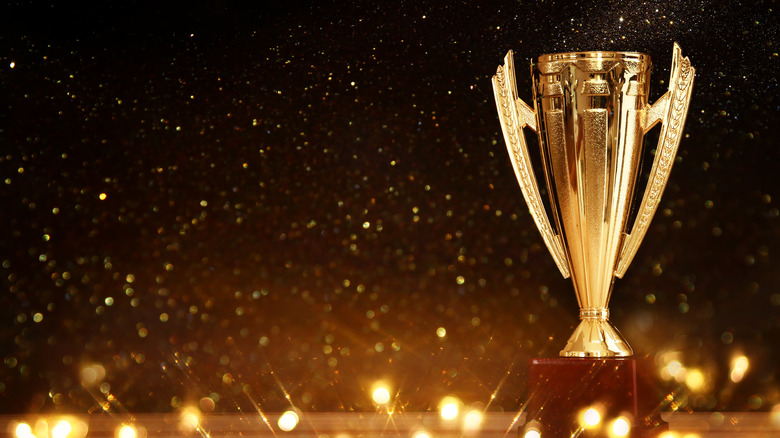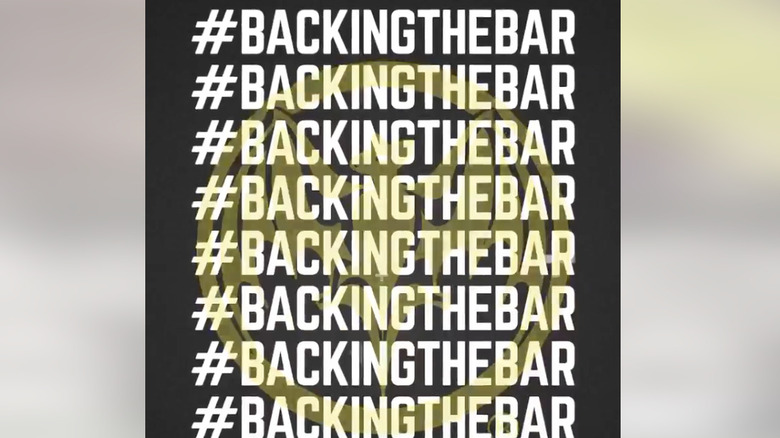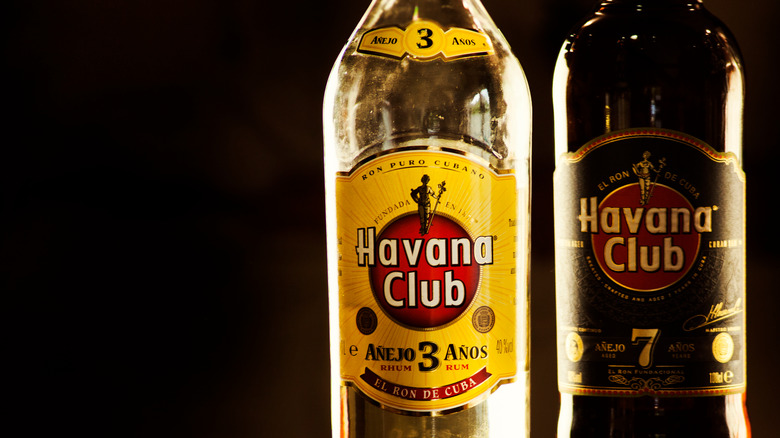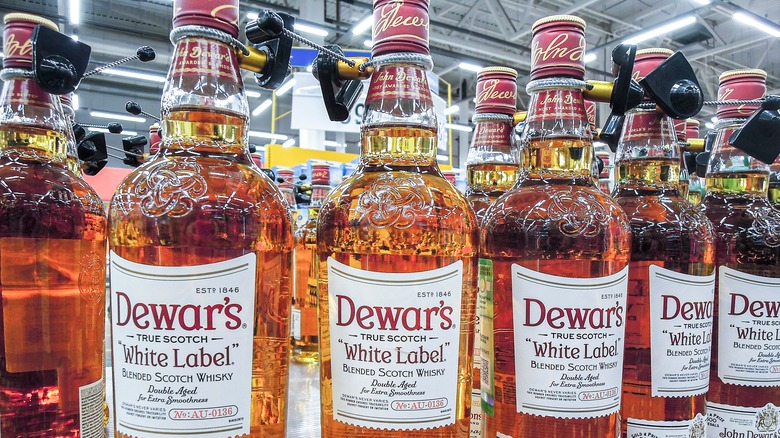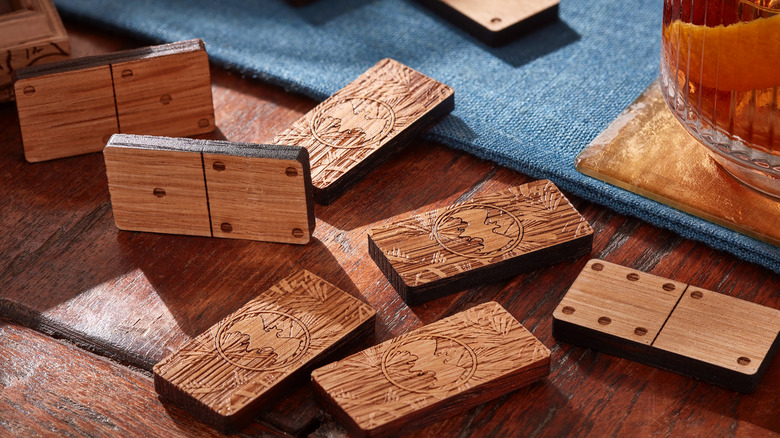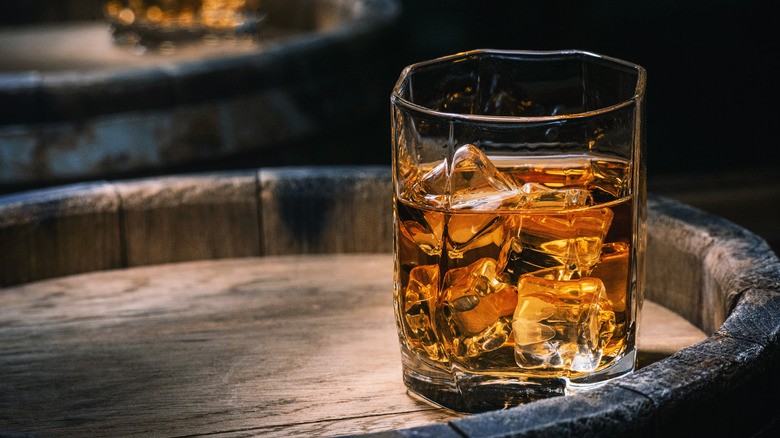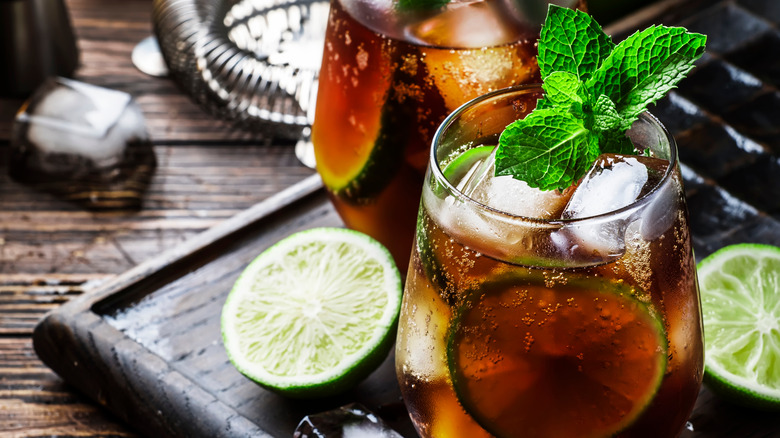The Untold Truth Of Bacardi Rum
Bacardi is one of the best selling rum brands in the world, favored for its smooth, mild taste with just the right amount of character. But its story is about more than daiquiris and piña coladas; it is a tale of political revolution, betrayal, bitter feuds, and wild success. Since its founding in Cuba 160 years ago, the company has been tied to the fate of the country itself. It started out simply enough in 1862, when Don Facundo Bacardi Masso created a rum whose comparatively docile flavor, he believed, would appeal to a wider clientele. He was right, of course. From then on, the family business would eventually grow to become a well-respected, international venture.
But there were plenty of turbulent times along the way, from natural disasters to national crises. So while generations of the Bacardi family were working to reinvent the world of spirits, they were also trying to reinvent the very world around them.
There was a Bacardi prophecy about a coconut tree named "El Coco"
In the world of liquor, coconut and rum is one of the great flavor pairings. But according to Bacardi family lore, the coconut tree is important for another reason, too.
When Don Facundo opened the first Bacardi distillery in Santiago de Cuba, he and his son planted a coconut palm that they affectionately called El Coco. In the years to come, El Coco — and the Bacardi family itself — would be tested by a series of disasters, including numerous earthquakes and hurricanes. Still, El Coco stood tall, and the family business survived.
So the Bacardis tied their fate to that of their beloved coconut tree. They felt confident that so long as El Coco persevered in Cuba, so would they. But before its centennial, the tree's life did come to an end. And whether one believes in destiny or not, the Bacardis' time in Cuba was short-lived after that; they were chased out of the country by Fidel Castro in 1960.
Bacardi rum continued to be produced in other nations after that, and each time a new distillery was opened, a coconut tree would be planted in honor of El Coco.
The Bacardi family was deeply intertwined with the Castro regime
According to the Bacardi company, Don Facundo moved from his home country of Spain to Cuba, a Spanish colony, when he was 15 years old. He grew up, launched his business, and raised his family on the Caribbean island, and the lot came to identify more with Cuba than their original European nation.
So when, in the 19th century, Cuban revolutionaries (with the help of the United States) fought to shirk their colonial status and become their own independent nation, Emilio Bacardi joined the cause (via NPR). Cuba became totally independent in 1902. Then, in the 1950s, a new set of revolutionaries vied for power, headed by Fidel Castro. The Bacardis threw their support behind this new nationalistic movement as well.
But shortly after Castro came to power, the highly successful company suffered a tremendous betrayal: The government seized all of their assets, forcing them to flee. While the business survived thanks to its holdings in other countries, the bad blood remained, and José "Pepin" Bosch (a Bacardi by marriage) actively worked with the United States government to oust Castro. According to The Guardian, Bosch even financed a CIA plot to assassinate him!
Bacardi's strain of yeast for rum is the oldest in Cuba
The Bacardi brand has survived for 160 years because of their business smarts. Even while they supported revolutionary movements in Cuba, they had the good sense to move their most important asset out of the country, just in case things didn't go well: their unique strain of yeast.
Literally called Bacardi yeast, it was first discovered by founder Don Facundo, and is the reason for the rum's beloved, smooth flavor. According to the LA Times, the company destroyed every last bit of the isolated yeast strain in Cuba before being forced to flee the country in 1960. This way, the Cuban government could never successfully replicate Bacardi rum, which would have made them lots and lots of money.
Bacardi facilities all over the world still rely on this yeast — the oldest Cuban rum yeast in existence.
Bacardi is actually two types of rum in one
While Bacardi yeast may be the most important ingredient that goes into making the brand's best-selling rum, it is not the only one. In addition to being the first to isolate this yeast strain, founder Don Facundo also invented a unique, parallel distilling process to produce his rum.
Rum, like other spirits, is made from a batch of raw materials called "mash." Typically, spirits are made from one type of mash, but Bacardi rum is distilled from two (via Difford's Guide). The final product, Bacardi Superior Rum, is actually the combination of light rum ("Redistalado") and a fruitier dark rum ("Aguardiente").
The two types of rum are aged side-by-side in separate wooden barrels until they reach maturity. Once they're ready, the two batches are blended together to make one superior spirit. This is how Bacardi keeps its distinct flavor while also being easier to drink than other rums.
Bacardi's bat logo carries a lot of cultural symbolism
The Bacardi logo consists of a black bat in a red circle. So, why the bat? There is actually both a personal story and a cultural story behind the choice. According to VinePair, founder Don Facundo's wife, Doña Amalia Bacardi, spotted fruit bats in their original facility in Cuba, which had, supposedly, been drawn to the sweet aroma produced by the molasses used to make Bacardi rum.
But there is also a greater symbolic meaning to the bat. According to Bacardi, the animal holds cultural significance in both Spain and Cuba. In Spain, the bat is seen as a bringer of fortune. The history behind this dates back to the 13th century (via Business Insider), when, legend says, a bat landed on a Spanish king's flag before his battle to reclaim Valencia from the Moors. They were successful, and the bat is now part of Valencia's coat of arms.
The Bacardi brand also writes that in Cuba, the bat is similarly seen as a symbol of protection. With the introduction of the logo, Bacardi soon became referred to by the local people as "El Ron del Muriciélago," or "The Rum of the Bat."
Bacardi rum has won 1,000 awards
Bacardi is one of the world's top-selling rums for a reason. According to PR Newswire, the brand has won an astounding 1,000 awards in its 160-year history, claiming the title of the most-awarded rum in the world.
Their winnings include awards earned at international competitions such as the Monde Selection, the International Wine and Spirit Competition, and the World Spirit Awards. Bacardi rum has also earned titles specific to United States contests, such as the San Francisco World Spirits Competition and the New York World Wine & Spirits Competition.
According to Spirited Biz, the brand also issues awards of its own to its various facilities for internal accomplishments. In an effort to achieve a 50% reduction in their global emissions by 2025 (via Business Wire), Bacardi has created the Bacardi Good Spirited Award, which is an annual prize given to individual employees or whole Bacardi facilities around the world that make significant yearly strides toward their environmental goals.
Bacardi partnered with the NAACP to help black-owned restaurants and bars
In the past couple of years, social upheaval in the United States over race relations has prompted a renewed focus on supporting Black-owned businesses, which historically receive significantly less financial investment (via Forbes). By partnering with the NAACP, Bacardi has worked to become a force for positive change with their Backing the B.A.R. (Black-Owned Accounts and Retailers) initiative. The joint initiative provides grants to various Black-owned restaurants and bars across the United States.
In 2021, Bacardi created their first NFT (non-fungible token) to celebrate the release of their limited-edition Reserva Ocho Sherry Cask Finish rum (via Marketing Dive). Online buyers place bids for unique digital files like these, like an auction. Bacardi has committed to donating the proceeds from these sales — as well as the sale of future Bacardi NFTs through 2025 — to Backing the B.A.R., in an effort to make the hospitality industry more equitable.
There is a feud between Bacardi and the Cuban government over Havana Club rum
The Bacardi brand has had a contentious relationship with the Cuban government ever since the mid-20th century, when they and fellow rum-makers the Arechabala family, owners of Havana Club rum, fled the country. At the time, Cuba's newly installed government, led by Fidel Castro, launched a campaign to seize Cuban rum companies' assets and make them government property (via Reuters).
Havana Club later became a subsidiary of Bacardi. Still, the Cuban government insists it has a right to sell rum under the Havana Club name. Those who visit Havana Club's website (appropriately, therealHavanaClub.com) will even find a section titled "Learn the Truth," which describes the feud in detail.
And it's more than just a bitter rivalry. In 2021, Bacardi filed suit against the United States Patent and Trademark office over who gets the rights to the Havana Club name. The lawsuit describes the Cuban government's use of the name as a "moral outrage."
Bacardi owns other major alcohol brands — not just rum
While it all started with Bacardi rum, the now global Bacardi Limited spirits company has several other liquor brands under its umbrella. Their catalog consists of all types of spirits, from Scotch whisky to moonshine. Famous names include Grey Goose, Patron, Dewar's, and Bombay Sapphire, among others. And it's not just liquor, but aperitifs, liqueurs, sparkling wine, and beer.
Bacardi Limited's brands contribute to the company's long tradition of quality by winning their own awards and accolades. Dewar's Double Double line of aged whiskies, for instance, has won in categories such as whisky of the year and best Scotch whisky (via Men's Journal). Bacardi, Grey Goose, and Martini were also Women's Choice Award winners in 2015 (via Bacardi Limited).
So the next time you go to a liquor store, take a look around and think about just how much of what you see is the property of Bacardi.
There is an official Bacardi dominoes set
Anyone can go to the Bacardi online shop and find a variety of fun games and accessories, like Bacardi-themed card decks and puzzles. Also available is a sleek, black Bacardi dominoes set. But the brand also launched a U.K. exclusive dominoes set that is much, much cooler.
The U.K. game pieces, as well as the box they come in, are made entirely from real Bacardi rum barrels (via The Luxury Editor). Each piece of the set is engraved with a custom Caribbean island-themed design and the Bacardi logo, rendered by Caribbean artist Yermine Richardson, a.k.a PopCaribe. And because the barrels once held aging rum, a lovely, smoky aroma still clings to the dominoes. The brand wants customers to enjoy the game, so the set also comes with a complimentary bottle of Bacardi Reserva Ocho Rum, which has been aged for eight years.
According to the New York Times, the game of dominoes itself is a Caribbean pastime. So when customers purchase a Bacardi dominoes set, they are experiencing part of Caribbean culture alongside their Caribbean rum.
A Bacardi rum cocktail should have six ice cubes
Casual drinkers and budding mixology enthusiasts alike want to know the same thing: how to make the perfect cocktail. Any experienced bar professional will say that it's all about the ratios of the ingredients. For their part, Bacardi insists that includes the exact number of ice cubes that go into the glass. According to the brand (via YouTube), the perfect Bacardi rum cocktail must have no fewer and no more than six cubes of ice.
They probably know what they're talking about, considering the company owned one of the first ice plants in Cuba back in the day. In an interview, Global SVP of Marketing Ned Duggan told Chilled Magazine of how anyone who bought a full case of Bacardi rum would receive one free ice token from the distillery. According to him, this was a great boon for bars at the time because they could boast that they served chilled cocktails — a luxury not everyone could enjoy. It's extra efforts like these that helped make the Bacardi brand as popular as it is today!
Classic cocktails like the Cuba libre and the daiquiri call specifically for Bacardi rum
Bacardi prides itself on being the rum that has helped spawn some of the world's classic cocktails. Remember how Emilio Bacardi fought for Cuban independence from Spain? The rum company attests that it was this period of liberation that inspired the Cuba libre cocktail (literally meaning "free Cuba").
The American troops that helped fight the war against Spain brought Coca-Cola with them to the Caribbean island. It was only a matter of time before the American soda drink was combined with the locally popular Bacardi rum for one delicious cocktail. According to Bacardi, it was the year 1900 when Captain Russell of the United States Army made the toast, "Por Cuba libre!" with a glass of Bacardi rum and cola with lime. (Difford's Guide even says that there is a sworn affidavit to the event by a witness who was there that day.) Thus, a legend was born.
Bacardi also takes credit for the invention of the refreshing frozen daiquiri. Global SVP of Marketing Ned Duggan says that the company's status as one of the first ice plants in Cuba ties it to the birth of the frozen alcoholic drink (via Chilled Magazine). He also claims that the original recipes for the mojito and the piña colada necessitate Bacardi rum. So if you want to make any of these cocktails the right way, do it with Bacardi!
